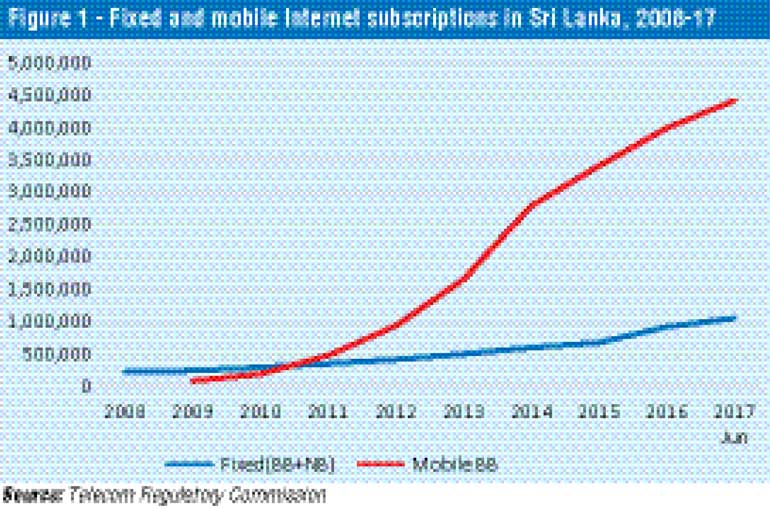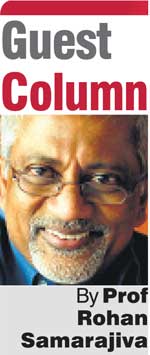Saturday Dec 14, 2024
Saturday Dec 14, 2024
Monday, 13 November 2017 00:00 - - {{hitsCtrl.values.hits}}

Along with most analysts, I have praised the 2018 Budget Speech. It is a forward-looking document consistent with preceding economic policy statements. When read with the new Inland Revenue Act, it appears to be a credible effort to balance revenue and expenditure. But as is to be expected in a complex document prepared under time pressure, it contains some errors that need to be corrected during the Budget Debate.
It appears that the Minister has already corrected an error with regard to the applicability of the new duties for electric vehicles. The rather large error discussed below is the Rs. 200,000 per-tower, per-month levy that, like the electric car duty revision, falls under the environmental proposals: the rationale is that cellular towers are an environmental and health hazard. The stated intention is to discourage proliferation of towers.
Towers and frequencies
If the Telecom Regulatory Commission (TRC), which has responsibility for the electromagnetic frequencies or spectrum which why one erects towers in the first place, had not been preoccupied by its internal problems, it may have pointed out the fallacy of the proposal. But sadly some kind of uninformed anti-tower bias within the Ministry of Finance appears to have carried the day. It may be noted that similar sentiments were expressed, but not acted upon, in the 2017 Budget Speech.

In 2016, the International Telecommunication Union (the UN’s specialised agency) stated: “The Asia and the Pacific region has the lowest average PPP$ price for mobile-cellular services of all regions. It is home to the countries with the lowest mobile-cellular price baskets worldwide: Sri Lanka and Bangladesh, where prices stand out at PPP$ 2.45 and PPP$ 4.14 per month.” Our standing may have changed because of the rather hefty taxes and levies imposed on mobile voice and data in the past year, but we would still be in the lower range.
Around 10 years ago, LIRNEasia was asked by Nokia to explain why countries in South Asia were able to offer such low prices for voice and data. Our answer was that intense competition had led the operators to adopt a Budget Telecom Network (BTN) business model. In the same way that budget airlines such as Air Asia make profits by implementing a budget airline business model, the region’s telecom operators had figured out how to function using a business model that was very different from those found in developed-country markets. Squeezing costs was a critical element of the model.
According to the TRC, in June 2017 we had around 5.5 million broadband and narrowband subscriptions, of which 80% were mobile, i.e., connecting the customer over a handset, a tablet or a dongle using a wireless connection. Wireless connections require frequencies and towers. Fewer frequencies are available, more towers are needed, and vice versa. They are integrally connected.
There are around 5,500 antenna towers in Sri Lanka. It appears the Government intends to raise around Rs. 13 billion from the Rs. 2.4 million annual levy per tower and around Rs. 2 billion from the levy imposed on bulk SMS used for advertising. Of course, if the intention is to reduce the number of towers, the revenue should decrease. The proposed levy is several times larger than what operators pay as rent for tower locations. Unlike a general levy of the type imposed in 2015, this is a powerful incentive that is likely to change the way operators design and maintain their networks.
The hope may be that operators will immediately start sharing towers, and discontinue the use of duplicative facilities. Towers come in all shapes and sizes. They have been engineered to carry specific loads. A lot of tower sharing is already happening.
It is unlikely that additional tower sharing will be practically feasible immediately. Costs of pulling down existing towers and building new towers that can carry multiple antennae are quite high. One result of the punitive levy may be discontinuance of service in areas with low yields. This is not a desirable outcome. Even in high-traffic urban areas, towers may be selectively decommissioned resulting in degradation of quality of service. Both rural and urban customers will be made unhappy. Growth in mobile broadband has been slowing since 2014 in absolute and percentage terms. Reduced coverage and degraded quality is likely to accelerate the decline.
Sri Lanka is an under-performer in ICT. The ITU’s ICT Development Index of 2016 had Sri Lanka behind countries like Viet Nam (11 places) and Indonesia (1 place) and about to be overtaken by Bhutan. The punitive levy is likely to make us fall back further.
Where to find Rs. 13 billion?
Despite the language about environment and health, the proposal is fundamentally about money. Even a patently silly revenue proposal is unlikely to be changed unless an alternative is presented. The answer is staring us in the face: Frequencies.
A majority of lower-income countries in South and South East Asia have only a total of 300-400MHz assigned to mobile operators, lower than in Europe or America where 600-700MHz is the norm. If the regulator acts quickly to release Digital Dividend frequencies in the 700MHz Band for mobile use as Sri Lanka has committed to, multiples of Rs. 13 billion can be brought into Treasury, directly and in the form of higher yields from taxes and levies.
German 700 MHz Band auctions in 2015 yielded approximately Euro 0.20 per person per MHz. The auction in Singapore yielded around 1.4 Singapore Dollars per pop/MHz. Corrected for GNP levels, it may be estimated that an auction of 50 MHz of frequencies in the 700 MHz Band will yield around $ 130 million for Treasury, much more than Rs. 13 billion. Auctioning the entire band will yield a lot more.
The 700 MHz Band frequencies that are optimal for wireless broadband will permit lower-cost, higher-quality connectivity. It may even reduce the number of towers over time. The Government will get money from the operators, without the perverse outcomes resulting from the ill-considered tower levy.